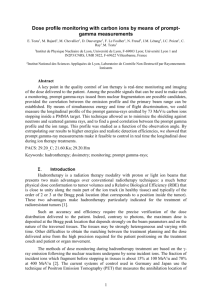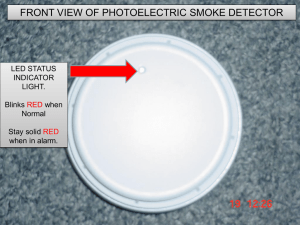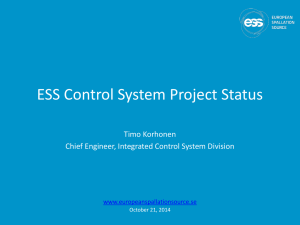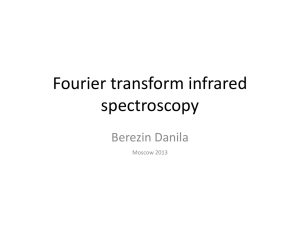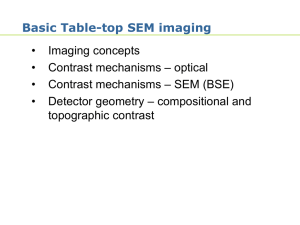Moving the 1.7 MV Pelletron to Jyväskylä
advertisement
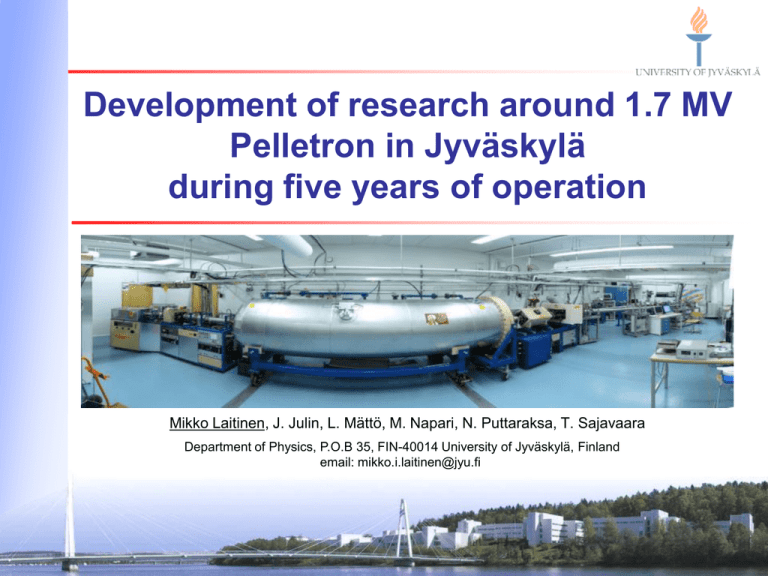
Development of research around 1.7 MV Pelletron in Jyväskylä during five years of operation Mikko Laitinen, J. Julin, L. Mättö, M. Napari, N. Puttaraksa, T. Sajavaara Department of Physics, P.O.B 35, FIN-40014 University of Jyväskylä, Finland email: mikko.i.laitinen@jyu.fi Outlook Background: Who we are Moving the 1.7MV Pelletron to Jyväskylä Water leak at the SF6 heat exchanger From corona needles to resistors Turbopumped stripper system installation Beamlines and recent developments ‘Contaminants’ after analyzing magnet University of Jyväskylä, Department of Physics (JYFL) University: Staff 2600, 15000 Students, 217 M€ turnover Department: Personnel 190, including 85 PhD students Physics department main research areas: • Nuclear and accelerator based physics • One team out of 8 : Accelerator based materials physics • Materials physics • High- energy physics NordForsk 2011: Comparing Research at Nordic Universities using Bibliometric Indicators Among 30 Nordic Universities, JyU is among the top four universities in Physics + Mathematics (“second place” after Aarhus U.) Accelerator based materials physics 1 Senior, no other staff, including engineers 4-5 PhD students (for example: ion beam lithography, detector development, direct signal digitization by fast digitizers) 4-6 Master (and bachelor) thesis students 24/7 working diffusion cloud chamber for physics department permanent exhibiton: Masters thesis project Commercial system price tag: 25-50k€ depending on size MOVING THE 1.7MV PELLETRON TO JYVÄSKYLÄ Acquisition of the Pelletron accelerator A coffee table rumor was heard in late 2006… … and quickly confirmed by indirect route The technical research center of Finland (VTT) had little usage of their accelerator and needed the room space for cleanroom extension.. …And our group in Jyväskylä needed an accelerator. 1.7MV 5SDH-2 Pelletron(serial number 002, made in 1985) with one (Alphatross) ion source and one beam line was donated to JYU by VTT Moving the accelerator from VTT Monday 18th of September 2006 Moving the Accelerator from VTT SF6 purity 88%! No moisture 19ppmV Purity analysis by Solvay Germany Herkunft Gebinde Gewicht Anteil SF6 1ATM of air+ 5bar SF6 overpressure! SF6 Luft CF4 CO2 SO2F2 SO2 S2F10 SF5-O-SF5 Vol-% Vol-% Vol-% Vol-% ppmv ppmv ppmv ppmv Art Nr. kg Wikeström, Helsinki Flasche 72356 28 18 65.2939 34.706 0.0206 Wikeström, Helsinki Flasche 74390 21 16 75.2364 24.231 0.0699 Wikeström, Helsinki Flasche 12780 30 28 93.8826 6.1131 Wikeström, Helsinki Flasche 9977952 33 30 89.6052 10.395 0.0022 0.0226 0.28837 0.01014 0.001 0.00009 0.00027 S2F10 was considered a potential chemical warfare agent in World War II because it does not produce lacrimation or skin irritation, thus providing little warning of exposure. LD50 levels about 15-25 ppm Monday 18th of September 2006 0.00516 0.00558 Moving the Accelerator from VTT Tuesday 19th of September 2006 Arriving at Jyväskylä after 330km 25th of September 2006 Building of the Pelletron lab Pelletron 5th of October 2006 Target hall 26th of of November October 2006 30th 2006 Installing of the Pelletron 14th of December 2006 Installing of the Pelletron 17th of December 2006 2nd of January 2007 Cleaning of the Pelletron 17th of January 2007 18th of January 2007 Powering up of the Pelletron acc. 6th of February 2006 Ion source cleaning + comissioning First RBS measurements Thick (550 nm) hydroxyapatite Thin (170 nm) hydroxyapatite 700 1200 Experimental O 1000 Experimental SIMNRA simulation 600 SIMNRA simulation 500 Yield Yield 800 600 Si-substrate Ca 400 400 300 200 P 200 100 0 0 150 250 350 450 Energy (ch) Ca/P ratio 1.18 550 120 220 320 420 520 Energy (ch) Ca/P ratio 1.33 Beam on target: 21.2.2007 Total commissioning time from ‘amateurs’: ~2months WATER LEAK AT THE SF6 HEAT EXCHANGER Water leakage from the heat EX First symptom: Voltage(GVM) didn’t go DOWN when chains were turned off Real signal: Voltage rised very poorly, even after long “conditioning” (about 1.5 weeks from first symptoms) Beginning of September 2007 Water leakage from the heat EX Measuring the purity of SF6: 99.6% (27.9.2007) Water content in SF6: 7500 ppmV !!! (19 @ VTT) 5th of October 2007 Water leakage from the heat EX 5th of October 2007, almost a month from first symptoms 9000 8000 7000 6000 5000 Problem verified Dry alumina changes 8000 7000 Water condensation @ ~7500ppmV H2O in SF6@2.7 bar, 24C 9000 Pressure changed in Vaisala dewpoint meter to 2.2 bar A lot of water out from alumina 4000 5000 4000 Pumping few days of the external heat exhanger tubing with dry scroll pump. 3000 2000 3000 2000 New alumina in -> gas circulation 1000 0 9/26/2007 6000 1000 0 10/3/2007 10/10/2007 10/17/2007 Time [days] 10/24/2007 10/31/2007 H2O content after dryer [ppmV] H2O content of SF6 in tank [ppmV] Water leakage from the heat EX Water leakage from the heat EX Conclusions and aftermath of the water leakage after tank opening + cleaning: There had been few cm of liquid water inside the tank bottom (“high water” -mark) New “pure” ion exchanged water at new lab might enhanced corrosion of the rusted Cu pipes of the original heat exhanger Only aftermath was most likely the GVM bearings that failed less than month later: forced tank opening and gas recovery FROM CORONA NEEDLES TO RESISTORS AND TURBOPUMPED STRIPPER SYSTEM INSTALLATION From corona needles to resistors 550 Mohm resistors ordered from NEC to replace some 60 corona gaps Resistor based charge division change was relatively easy, except tight space Lower voltages far more stable, accelerator has been run with 75kV at terminal From corona needle based voltage division to resistors 2008 Turbopumped stripper change Original: N2 gas stripper, extra gas pumped through HE- beam tube. Recirculation by turbo: About order of magnitude lower pressures at HE-side for same charge state distributions, even with larger holes at LE and HE terminal. Less beam (charge state-)contamination due to residual stripper gas. High water-mark Turbo pumped stripper system 2012: higher transmission BEAM LINES AND RECENT DEVELOPMENTS The lab and the beam lines 2009 Low energy heavy ion ERDA Typically 1–20 MeV Cl, Br, I or Au ions from 1–3 MV tandem accelerator Time-of-flight–energy spectrometers for isotopic identification and energy spectrum measurement 63Cu Time of flight (velocity) and energy are measured for the same particle E=½mv2 → m=2E/v2 Different masses can be identified Example: Thin film with high mass element Atomic layer deposited Ru film on HF cleaned Si Scattered beam, 35Cl, used for Ru deph profile Monte Carlo simulations needed for getting reliable values for light impurities at the middle of the film Ru SiO2 Si Poor E resolution Low energy heavy ion ERDA – See posters! Gas ionization detector to replace Si-energy detector Why try to fix a well working system? Greatly improved energy resolution for low energy heavy ions → heavier masses can be resolved Gas detector is 1D position sensitive by nature → possibility for kinematic correction and therefore larger solid angles possible Gas detector does not suffer from ion bombardment Recoil ranges in isobutane 10.2 MeV 79Br 8.5 MeV 35Cl Gas ionization detector develoment – See posters! Gas detector performance Same borosilicate sample is measured with ToF-E, with two different energy detectors: a gas ionization detector with thin SiN window and new Si-detector H = 290 keV B = 2.4 MeV Beam: 10.2 MeV 79Br Si = 4.5 MeV Gas ionization detector with thin SiN window ‘Contaminants’ after analyzing magnet 13.6 MeV 63Cu7+ CaPO (hydroxyapatite) Stripper N H C Cu beam Si Multiple (charge) states of same ion but with different energies bend at the analysing magnet through same slit to same angle O P Ca Is this mostly due to stripper gas effect in HE column? Acknowledgements TEKES-EU Regional Funds Academy of Finland TEKES Accelerator based materials physics group at JYFL Pelletron Laboratory 25 years old 1.7 MV Pelletron accelerator, in Jyväskylä since 2006 Available beams and energies: from H to Au, from 0.2 MeV to 20+ MeV Three ion sources within ~2 m2 ! Ion sources Mean life time of the ion source more important than 2×more beam Maintained by group, development together with ion source team Ion source name Ion source type primary ion(s) Typical intensities Alphatross 100 MHz RF, Rb charge exhange He - 250 nA SNICS '1' Cs sputtering, single cathode 2 000 nA PELLIS Filament driven multicusp C-, Cl -, Cu-, BrH- 15 000 nA Typical operational parameters filament P, Einzel oven T focusing HV Ion source name "cathode" HV, current 'Extraction' lens HV Alphatross +5 kV, 0.75 mA 250 oC / 55 oC none -8 kV SNICS '1' -4 kV, < 0.2 mA 19 A, 6 V -8 kV -8 kV PELLIS +100 V, 1 A 70 A, 3 V -5.5 and -3.4 kV -10 kV Where does the ions end up Example: Thin film with high mass elements In ALD impurites from carrier gas or precursors may interfere in the process EXAMPLE: LiTiO thin film, ~50 nm : Cl35 VS Br79 • 35Cl close to perfect beam but cannot probe the Cl impurities in the film • Heavier 79Br beam needed for this ’same as beam mass impurity’ search • Br beam suffers from multiple scattering and cannot probe whole film H H 6Li 7Li No Chlorine impurities seen 6Li 7Li C C O Na Ti O Na 79Br Cl Ti 35Cl 35Cl as primary beam 79Br as primary beam Poor E-resolution for heavy elements Low energy heavy ion ERDA Lithography with light ions Ion beam lithography enables direct writing of deep ’3D’ structures, for example microfluidistic channels to the resists (PMMA) or even quartz. Stability in energy and fluence most critical, as for very small beam sizes the online monitoring is challencing. Uniform beam(up to ~30%), parallel exposure trough slits → fast prototyping. Depth defined by ion range Lithography with light ions Ion beam lithography enables direct writing of deep ’3D’ structures, for example microfluidistic channels to the resists (PMMA) or even quartz. Stability in energy and fluence most critical, as for very small beam sizes the online monitoring is challenging. Example which has OK parameters diffusor Example with parameters NOT OK Pump unit Beam shift due to Alphatross sparking Reservoirs Detection/readout Fluence change→ not well developed Need for negative helium Rutherford Backscattering Spectrometry (RBS) uses often He to probe the sample from the surface (few 10’s of nm to few µm). Higher the energy, lower the backscattering yield, but better mass resolution (and relative energy resolution at silicon detector). Lower the energy, better the depth resolution, but worse transmission through the accelerator → High He input current needed from ion source. EXAMPLE: RBS for Pb that has diffused in glass at elevated temperatures 1250 1000 750 As-implanted = highest peak for every dose o 460 C 1 h o 480 C 1 h o 500 C 1 h o 520 C 1 h o 540 C 1 h o 560 C 1 h = lowest peak for every dose 500 250 0 200 175 Intensity [counts] Intensity [counts] 1500 50 keV Pb implantation doses in glass -2 1E16 at. cm -2 3E15 at. cm -2 1E15 at. cm -2 3E14 at. cm 150 125 100 75 50 50 keV Pb implantation doses in glass -2 1E16 at. cm -2 3E15 at. cm -2 1E15 at. cm -2 3E14 at. cm 2 more doses! - 1E14 at. cm-2 - 3E13 at. cm-2 25 0 1472 1488 1504 1520 1536 1552 1568 1584 1600 Backscattered energy [keV] 1472 1488 1504 1520 1536 1552 1568 1584 1600 Backscattered energy [keV] What is needed: Conclusions I ToF-ERDA: Selection of heavy ions that are fast to switch, stability in intensity not that important but higher charge states from small accelerator is needed for reasonable count rates. Lithography: Stability in both energy and intensity most important. Light ions can create deep ’open’ structures where heavy ions can create closed channels directly (Bragg peak). RBS: Helium beam most used beam as it can separate heavy target/sample masses from each other PIXE (particle induced x-ray emission): Protons or helium most often used. Data can be collected often together with other methods easily. What is needed: Conclusions II For ion beam applications, for both characterization and modification variety of negative ion beams is needed. Stable in energy and fluence, easy to maintain ion sources are priority parameters over higher beam intensities. Protons: PELLIS H- source performs very well with long life times and is easy to operate by users. Helium: Alphatross currently has poor to worse performance. Upgrades coming: helical RF-plasma coupling and temperature stabilized Rb charge exchange chamber for stable Rb backflow to oven. Heavy ions: SNICS ’1’ has moderate performance. ”New” 40 MC-SNICS to be installed still in this year. Growth of Al2O3 on TiO2 In dye sensitized solar cells even single ALD cycles of Al2O3 were found to reduce the interfacial electron transfer between semiconductor TiO2 and dye molecule. This improves the performance of the cell. How thick films of Al2O3 were deposited during first cycles of ALD growth? Liisa Antila, Mikko Heikkilä, Viivi Aumanen, Marianna Kemell, Pasi Myllyperkiö, Markku Leskelä, and Jouko E. I. Korppi-Tommola J. Phys. Chem. Lett. 1, 536 (2010). 50 nm ALD-TiO2 Minimizing background Sample: 50 nm TiO2 on Si substrate where 5 ALD cycles of Al2O3 has been grow on to (corresponding 0.5 nm thickness) All counts visible on log intensity scale 5 ALD cycles of Al2O3 50 nm TiO2 Si substrate Growth of Al2O3 on TiO2 Samples with 1, 2, 3 and 5 cycles of ALD Al2O3 on 50 nm ALD TiO2 were studied Measurements using 8.26 MeV 79Br beam 5 ALD cycles Conclusion: Al2O3 film growth starts rapidly from the first cycles and then the growth rate per cycle reduces Timing gates: construction Carbon foils T1 foil 3 µg/cm2 (diameter 9 mm) T2 foil 10 µg/cm2 (diameter 18 mm) Determines solid angle of 0.29 msr Distance between foils 633 mm Wires in the electrostatic mirror grids Spot-welded 25 µm diameter Au wire Wire-to-wire distance 1 mm, 97.5% transmission, telescope transmission 87% Micro-channel plates Low-cost chevron-type MCP assembly from TECTRA Active diameter >40 mm, pore size 12 µm, channel length/diameter 40:1 Specified only for 10 ns timing resolution! TOF detection efficiency (%) Detection efficiency against energy detector Sample holder backwall All sample elements, including H, can be detected and quantified No pinholes in C foils typical ERDA energies hydrogen carbon Timing resolution for He and H Current timing resolution 155 ps (FWHM) for 4.8 MeV incident He ions and 235 ps for 0.6 MeV incident H ions scattered from 1-2 nm Au film on SiO2/Si substrate 4.8 MeV He 0.6 MeV H Au 9 keV 235 ps 155 ps For He 155 ps timing resolution gives 32 keV resolution at 4.8 MeV but 0.8 keV resolution at 400 keV! Si Example: Diamond-like carbon films 2.3 µm thick diamond-like-carbon film on Si, measured with 9 MeV 35Cl All isotopes can be determined for light masses Light elements can be well quantified (N content 0.05±0.02 at.%) Low energy heavy ion ERDA Selection of coincident events Time-stamp resolution 25 ns. TOF energy ADC n:o 0 1 0 1 0 0 1 Ch 2675 2624 3756 1332 6688 3044 1987 Timestamp 457669383399 457669383471 457669459909 457669459982 457669499237 457669862394 457669862467 Lonely TOF-event, has probably hit T2 detector C-foil frame Selection of coincident events Coincidence <10µs, 585117 counts 1.6-1.9 µs, 576741 counts 1725-1750 ns, 329445 counts outside peak, <10µs ANALYSIS OF THE Al2O3/TiO2 NANOLAMINATES Measurements 35Cl5+ 9.9 MeV - all samples, reflectance 69.5° geometry and 84° Quick test to all samples with standard 1 MeV 4He1+ RBS at 168° RBS - R2, 10 nm layers Si Ti O Al ToF-E, R2, 10 nm layers Measurements 6.0 MeV 12C3+ - 3 thinnest layered samples, 84° and 86° 0.5 MeV 4He1+ - Rutherford Scattering to forward angles up to 88° Sample R3, 5 nm layers Sample R4, 2 nm layers Monte Carlo -simulations MC-simulations made for the spectra in reflectance geometry Better undertanding of the composition and thicknesses Sample R2, 10 nm layers, start profile Difference comes from the incomplete selection of Al counts from Si substrate (does not effect MC-result) FURTHER IMPROVEMENTS Gas ionization detector Thin (~100 nm) SiN window Electrons for T2 timing signal emitted from the membrane Conclusions All Al2O3/TiO2 nanolaminates could be depth profiled and impurities, including hydrogen were analyzed Nanolaminates with individual layers of 5 nm could be resolved Depth resolution of <2 nm at the surface was reached Gas ionization detector as an energy detector and yet coming position sensitivity will push the performance to even higher level Future improvements: Gas ionization detector TOF-E results from ETH Zürich Incident ion 12 MeV 127I and borosilicate glass target Nucl. Instr. and Meth. B 248 (2006) 155-162 200 nm thick SiN membrane from Aalto University, Finland, on 100 mm wafer ALD 8.6 nm Al2O3/Si Atomic layer deposited Al2O3 film on silicon (Prof. Ritala, U. of Helsinki) Density of 2.9 g/cm3 and thickness of 8.6 nm determined with XRR (Ritala) Elemental concentrations in the film bulk as determined with TOF ERDA are O 60±3 at.%, Al 35±2 at.%, H 4±1 at.%. and C 0.5±0.2 at.% 10 nm CNx on silicon TOF-ERDA results from sputter deposited 10 nm thick CNx hard coating on Si. Measured with 6 MeV 35Cl beam and extreme glancing angle of 3° A density of 2.0 g/cm3 was used in converting areal densities to nm Effect of stripper gas pressure 13.6 MeV 63Cu7+ CaPO (hydroxyapatite) Timing resolution Shape of the MCP signal with the original anode Risetime ~3 ns for He ions Electronics and data acquisition Timing gates Fast Phillips Scientific 776 preamplifier (10×) Ortec 935 quad CFD FAST 7072T TDC/ADC, no delay used Energy detector Implanted 450 mm2 ORTEC detector (ULTRA series) Ortec 142 preamplifier Ortec 571 amplifier FAST 7072T TDC/ADC Data acquisition with LabVIEW National Instruments FPGA card based multiparameter data acquisition system, programmed in Jyväskylä 40 MHz (25 ns) time stamping Can host up to 8 ADCs, easily expandable List-mode data – coincident events determined offline! Depth resolution optimization TOF-ERDA beamline and chamber UHV compatible chamber with a load lock LabVIEW controlled stepping motor driven 6-axis goniometer (Panmure instruments) Currently sample holder for two samples, holder for 7 samples in design Beamline equipped with high precision slits and NEC beam profile monitor Telescope angle 41º Timing gates: voltages 10 kΩ ions 40 MΩ MCP stack and ”toblerone” HV2: –1800 V HV1: –2800 V Carbon foil and outer mirror grid e- 10 kΩ 1699 V 20 MΩ 99 V 1 MΩ Cable from anode to SMA leadthrough Towards position sensitivity Risetime of 1 ns with PCB anode achieved with the test detector Risetime of 2 ns from lower MCP electrode through 1 nF capacitor achieved with the test detector Also ALD-Al2O3 coated carbon foils have been fabricated, much higher electron yields expected Conclusions New high performance spectrometer has been built in Jyväskylä Detector telescope has high detection efficiency and good timing resolution Depth resolution of <2 nm at the surface has been reached Position sensitivity and gas ionization detector as an energy detector will push the performance to even higher level 1st timing detector, 3 μg/cm2 C-foil 2nd timing detector, 10 μg/cm2 C-foil

